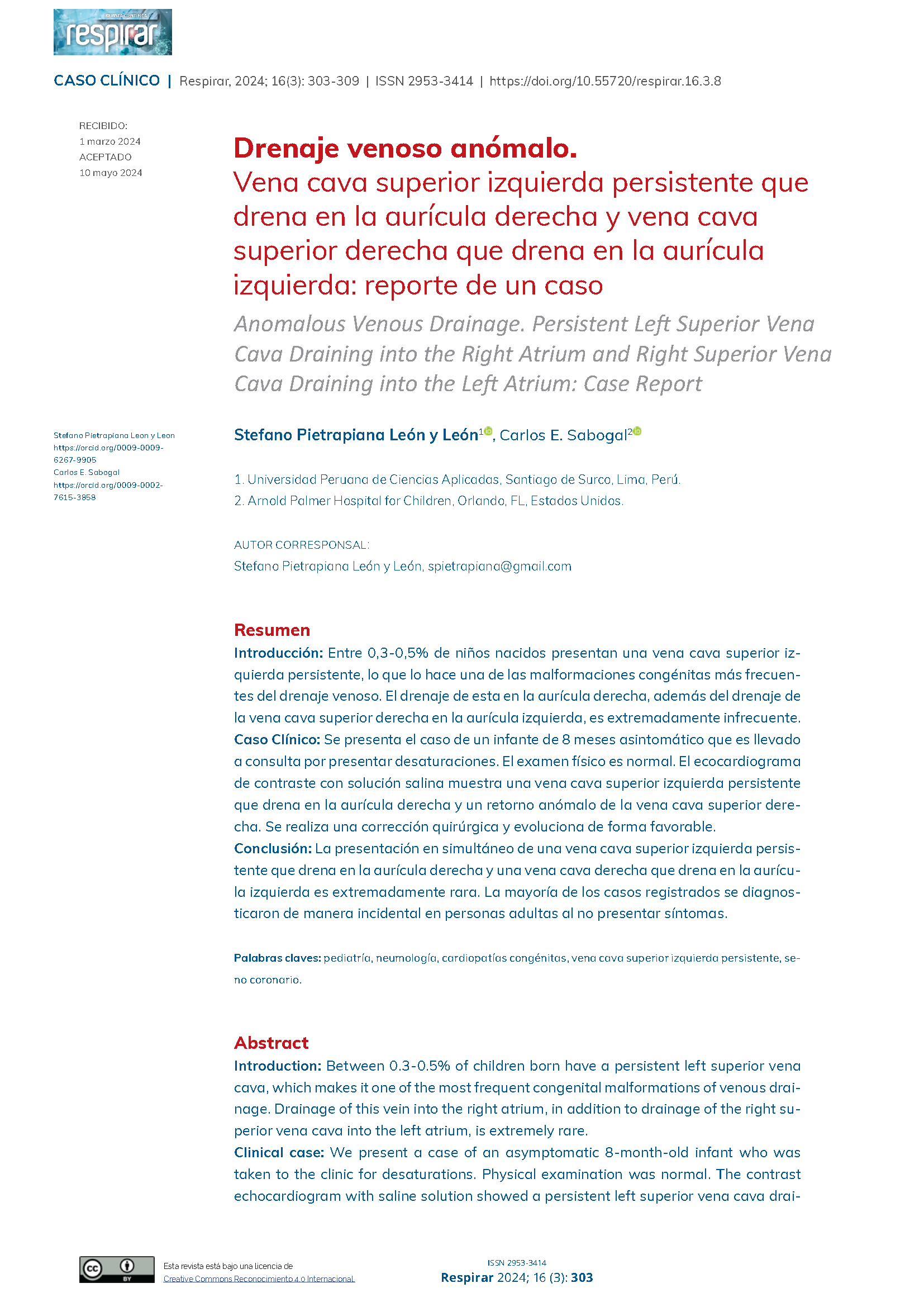Drenaje venoso anómalo. Vena cava superior izquierda persistente que drena en la aurícula derecha y vena cava superior derecha que drena en la aurícula izquierda: reporte de un caso
Contenido principal del artículo
Resumen
Introducción: Entre 0,3-0,5% de niños nacidos presentan una vena cava superior izquierda persistente, lo que lo hace una de las malformaciones congénitas más frecuentes del drenaje venoso. El drenaje de esta en la aurícula derecha, además del drenaje de la vena cava superior derecha en la aurícula izquierda, es extremadamente infrecuente.
Caso Clínico: Se presenta el caso de un infante de 8 meses asintomático que es llevado a consulta por presentar desaturaciones. El examen físico es normal. El ecocardiograma de contraste con solución salina muestra una vena cava superior izquierda persistente que drena en la aurícula derecha y un retorno anómalo de la vena cava superior derecha. Se realiza una corrección quirúrgica y evoluciona de forma favorable.
Conclusión: La presentación en simultáneo de una vena cava superior izquierda persistente que drena en la aurícula derecha y una vena cava derecha que drena en la aurícula izquierda es extremadamente rara. La mayoría de los casos registrados se diagnosticaron de manera incidental en personas adultas al no presentar síntomas.
Detalles del artículo
Sección

Esta obra está bajo una licencia internacional Creative Commons Atribución 4.0.
Cómo citar
Referencias
Baggen VJM, van Woerkens LJPM, Kauling RM, Dirkali A. A rare finding on computed tomography angiography performed to exclude pulmonary embolism. Neth Heart J 2023;31(4):170-171. Doi: 10.1007/s12471-022-01744-1.
Pecoraro L, Boninsegna E, Simonini E, Francia P, Colopi S, Pietrobelli A. Unexplained Hypoxemia in School-Age Child: Do Not Forget the Double Superior Vena Cava. Children 2022;9(9):1272. Doi: 10.3390/children9091272.
Clark C, MacDonald L. Right-sided superior vena cava draining into the left atrium in a patient with persistent left-sided superior vena cava emptying into the right atrium diagnosed by echocardiography. Proc (Bayl Univ Med Cent) 2015;28(3):365-6. Doi: 10.1080/08998280.2015.11929276.
Hulten EA, Pinto G, Weissman G, Fuisz A, Hulten E, Service C. Images in Cardiovascular Medicine Anomalous Vena Caval Return to the Left Atrium. Circulation 2012;125:525–8. Doi: 10.1161/CIRCULATIONAHA.111.019521/-/DC1.
Ríos G, Caicedo VM, Orjuela H, Santos H, Núñez F, Andrade D. Cirugía cardiovascular pediátrica - presentación de casos. Rev Colomb Cardiol 2012;153–6.
Usalp S, Karaci AR, Gülcihan Balcı K, Yazıcıo V, Arat Koc N. Right Superior Vena Cava Draining into the Left Atrium. Clin Med Rev Case Rep 2016;3(10):134. Doi: 10.23937/2378-3656/1410134.
Restrepo G, Trespalacios E, Ahumada S, Toro N. Vena cava superior izquierda persistente. Rev Colomb Cardiol 2014; 21(2): 115-118. Doi: 10.1016/S0120-5633(14)70263-3.
Theodore AC. Measures of oxygenation and mechanisms of hypoxemia. UpToDate. 2023. [Internet]. [Consultado 2 ene 2024]. Disponible en: https://www.uptodate.com/contents/measures-of-oxygenation-and-mechanisms-of-hypoxemia.
Fauci AS, Jameson JL, Hauser SL, Loscalzo J, Kasper D, Longo D. Harrison’s Principles of Internal Medicine. 20a ed. McGraw-Hill Education, 2018; Vol. 1; pp. 234–237.
Bhutta BS, Alghoula F, Berim I. Hypoxia. StatPearls. 2024. [Internet]. [Consultado 23 ene 2024]. Disponible en: https://www.ncbi.nlm.nih.gov/books/NBK482316/
